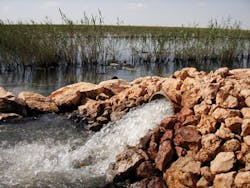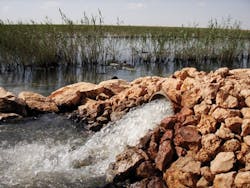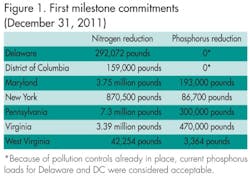EPA Regional Focus: Spotlight on the Mid-Atlantic
EPA Region 3 is home to the nation's largest estuary, the Chesapeake Bay watershed. The goal of the Chesapeake Bay TMDL is to reduce the amount of nitrogen, phosphorus and sediment entering the Bay from the six Bay states -- Delaware, Maryland, Pennsylvania, Virginia, West Virginia, and New York -- and the District of Columbia. Another major issue in the Region is mountaintop mining. In response to a settlement in the case of Bragg v. Robertson, EPA prepared an environmental impact statement looking at the effects of mountaintop mining in the Appalachia region.
By Angela Godwin
EPA Region 3 comprises the states of Delaware, Maryland, Pennsylvania, Virginia, West Virginia, and the District of Columbia. It is also home to the nation’s largest estuary, the Chesapeake Bay watershed. This enormous and complex ecosystem spans more than 64,000 square miles and contains over 100,000 lakes and streams.
Over the past several decades, the watershed has suffered serious degradation from industry and urbanization. As such, restoring the health of the Chesapeake Bay and its tributaries is a chief objective for EPA’s Mid-Atlantic Region.
To that aim, in December 2010 EPA issued the Chesapeake Bay TMDL, the most complex TMDL ever undertaken by the agency. This “pollution diet,” as it’s been called, is actually comprised of 92 smaller TMDLs pertaining to individual segments of the watershed.
The goal of the Chesapeake Bay TMDL is to reduce the amount of nitrogen, phosphorus and sediment entering the Bay from the six Bay states Delaware, Maryland, Pennsylvania, Virginia, West Virginia, and New York and the District of Columbia. It sets forth total load limits for each of those pollutants: 185.9 million pounds of nitrogen, 12.5 million pounds of phosphorus and 6.45 billion pounds of sediment per year. Those limits reflect a 25 percent reduction in nitrogen, 24 percent reduction in phosphorus and 20 percent reduction in sediment, to be attained by 2025. In the meantime, an interim goal of 60% of that final target has been set for 2017.
The TMDL also outlines an extensive accountability framework, including local Watershed Implementation Plans (WIP), two-year milestones, progress tracking and assessment, and specific federal actions each jurisdiction can expect if commitments are not met.
Restoration of the Chesapeake Bay is led by the Chesapeake Bay Program, an extensive regional partnership consisting of the states of Maryland, Pennsylvania and Virginia; the District of Columbia; the Chesapeake Bay Commission, a tri-state legislative body; the Environmental Protection Agency; and several citizen advisory groups.
The first two-year milestone of the TMDL is fast approaching. By December 31, 2011, the Chesapeake Bay jurisdictions are expected to meet certain specific short-term goals on their way to full compliance by 2025. At the July 2011 meeting of the Chesapeake Bay Commission’s Executive Council, members said jurisdictions were “currently on track or ahead of schedule” in meeting the first set of two-year milestone commitments (see Fig. 1).
Meeting these 2011 milestones will reduce total nitrogen loads by 6.9 million pounds and phosphorus loads by 463,948 pounds.
Another issue at the forefront of the Mid-Atlantic Region’s agenda is mountaintop mining. In 2005, in response to a settlement in the case of Bragg v. Robertson, U.S. EPA in conjunction with other federal and state partners prepared an environmental impact statement looking at the effects of mountaintop mining in the Appalachia region.
Over 1,200 stream segments in a 12 million acre region spanning most of eastern Kentucky, southern West Virginia, western Virginia, and parts of eastern Tennessee were evaluated. Results indicated a number of environmental concerns, including an increase of zinc, sodium, selenium, and sulfate levels in waterways. It also found that streams were sometimes covered up; in other instances, low-quality wetlands were created (intentionally or otherwise). In fact, it’s been estimated that nearly 2,000 miles of Appalachian headwater streams have been buried by mountaintop coal mining.
In the years since that environmental study, a number of initiatives have been introduced in the Mid-Atlantic Region to protect healthy waters and restore degraded waters within watersheds affected by coal mining.
Most recently, in July 2011, EPA issued final guidance on Appalachian surface coal mining that replaced previous guidance released in April 2010. While not a “rule” or legally binding, the guidance does, according to EPA, enable the agency’s regional offices “to work together with states, the U.S. Army Corps of Engineers, mining companies, and the public towards a balanced approach that protects communities from harmful pollution associated with coal mining.”
In 2010, EPA had success doing just that. The agency worked closely with Hobet Mining in West Virginia to devise a Clean Water Act permit it could stand behind. Under its original permit, the Hobet 45 mine would have buried nearly six miles of headwater streams and contaminated downstream waters. In the end, however, the revised permit eliminated nearly 50 percent of anticipated stream impacts.
On the other end of the spectrum is Mingo Logan Coal Company’s Spruce No. 1 Mine in Logan County, WV. The Spruce Mine has been described as the largest mountaintop coal mining operation ever proposed. And with that, environmental concerns mounted. The project has been held up by litigation for nearly 13 years.
Chief among concerns were estimates that the Spruce No. 1 Mine operations would bury over 7 miles of headwater streams, directly impact 2,278 acres of forestland and degrade water quality in streams adjacent to the mine.
Last year, in March 2010, EPA announced its recommendation that the U.S. Army Corps of Engineers revoke the mine’s permit, which had originally been granted in 2007.
“Coal, and coal mining, is part of our nation’s energy future, and for that reason EPA has made repeated efforts to foster dialogue and find a responsible path forward. But we must prevent the significant and irreversible damage that comes from mining pollution and the damage from this project would be irreversible,” said EPA Regional Administrator for the Mid-Atlantic, Shawn Garvin, in a press statement.
In January 2011, the agency made it official by exercising its rarely used veto authority under Section 404(c) of the Clean Water Act to halt disposal of Spruce mining waste in two streams and their tributaries.
The battle is far from over, however. Arch Coal, parent company of Mingo Logan, said it intends “to vigorously defend the Spruce permit by all legal means.” In the meantime, some Spruce mining operations are legally underway at the Seng Camp Creek mine. Here, EPA reached a permit agreement with Mingo Logan under separate litigation.
These are just a few examples of significant initiatives in EPA’s Mid-Atlantic Region. For more information on the agency’s priorities and initiatives, visit epa.gov/aboutepa/region3.html.
WW
More WaterWorld Current Issue Articles
More WaterWorld Archives Issue Articles


